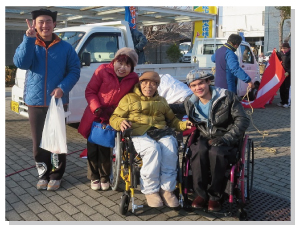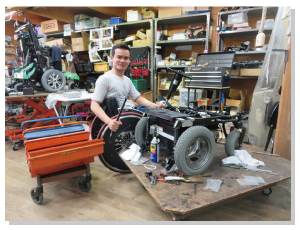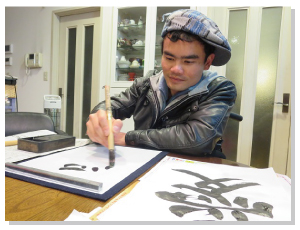- HOME
- Alumni News
- Namchok Petsaen (15th trainee)
- Dom's Final Report
Dom's Final Report
Empowerment of the Disabled Community in Asia
1. New experience
Japanese language lessons
For the first 3 months, I studied the Japanese language. I started with simple greetings such as ‘Konnichiwa. Ogenki desuka?’ The language study was really tough, but it was a fun and fruitful experience.
Homestay
During the homestay I learned a great deal about Japanese culture. I stayed with Kondo san and Keiko san. Keiko san was an amazing cook, and whenever she was in the kitchen I would help her and we would talk a lot. I also asked her many questions. For example, I wanted to know what she thought about being barrier-free in Japan, what types of jobs disabled people had in Japan, how she and her husband got married, and how they met in the first place, etc. The couple had been living together for over 50 years, which was wonderful.
I also had conversations with Kondo san. He was 70 years old and had been a wheelchair user for 60 years. He was doing really well. Before coming to Japan, I had not at all believed that someone with a spinal cord injury would be able to live long. So I consulted Kondo san about my concerns. I asked him about the secret of his longevity, what he ate and drank what he did daily, and so on. Because I had the same disability as Kondo san, I talked a lot with him and sought his advice. I had such a wonderful time with them. They both were role models for people with disabilities. I am very thankful to Kondo san and Keiko san.

2. The barrier-free concept
Barrier-free in Japan
My home and university were far from being barrier-free, so I wanted to learn about the concept and its implementation in Japan. Accordingly, I visited numerous barrier-free facilities in Japan as part of my individual training. In Japan, I could go anywhere on my own, which contrasts with my immobility in Thailand. When I first saw braille blocks on pedestrian paths in Japan, I did not know what they were. In fact they made the surface of the street unsmooth and were just an obstruction to me in the wheelchair. So I asked my friend why they were there, and found out that they were route finders for people with visual impairments. Then my thinking changed. Braille blocks are such a great example of ‘universal design,’ enabling those with visual impairment to travel independently.
Barrier-free housing for disabled people
Kondo san and Keiko san’s house had a very fine barrier-free design. One could move about freely in a wheelchair in and outside the house. That was my first time to see a barrier-free house for a disabled person. If I ever get rich in the future, I want to build a completely barrier-free house. My current house is very inconvenient.
3. Japanese technology
New technology
I learned about new technology at the Kanagawa Institute of Technology. I love robots and asked professors many questions. My favorite was the Power Assist Suit: wearing this suit, a caretaker is able to lift clients who would otherwise be too heavy. It was such an interesting technology.
Wheelchair designs
At Saito Kobo, I learned about wheelchair designs. I was introduced to a variety of wheelchair designs and gave some of them a try. I also learned about how to design electronic wheelchairs. I had a fruitful time at Saito Kobo.

4. The idea of ‘Independent Living’
I made visits to several Centers for Independent Living (CILs), such as Hoshizora, Kirara, Iruka, Muchu, and the Human Care Association. At these centers I learned about the ideas of independent living, peer counseling, personal assistant systems, and support services for people with disabilities. Underlying the concept of CIL is self-choice, which I found inspiring. I was very much fond of CIL Muchu, where I enjoyed ten-pin bowling, cooked Japanese and Thai food, and exchanged aspects of Japanese and Thai cultures with its members. I also clinked glasses, saying “Kampai,” countless times. It was so much fun, and I felt very happy and energetic.
5. A thought on ‘leadership’
I learned a good concept of leadership. We have a number of issues to be tackled in Thailand. There are many potential leaders in our country, but I did not know what it meant to be a good leader and why we had so many problems. What does leadership mean? Who is a good leader? What does a good leader do? – 10 months ago, I had so many questions. Once my training began, I was able to meet great Japanese leaders, including Mr. Kono, the president of Duskin Tsubaki Co., Ltd., Ms. Hirashita, and Mr. and Ms. Nakanishi. I talked with them a lot and also studied hard, and thereby gained a new concept of leadership. Now I know that a good leader can clarify and communicate a mission, vision, and goal, based on which she can build a team where people work together. When I go back to Thailand, I will share this idea of leadership with others.
6. Conclusion
During the 10 months of training, I have gained some really useful concepts and information. I had many new experiences and was able to explore the barrier-free concept, related Japanese technology, and the ideas of both CIL and leadership. I am excited about sharing my newly obtained knowledge with my fellow country people once I return home. I am joining you in the work of empowering people with disabilities in Asia. Thank you very much.





